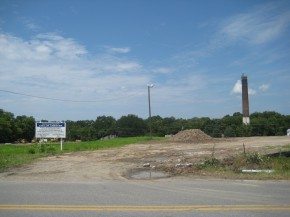
Chester City Administrator Jeff Kerr isn’t exactly sure what to call the phase of work on the Springsteen Mill property, but he knows good things are happening.
The initial studies on the formerly blighted mill were considered Phase I, but Kerr said the tear-down and clean-up was Phase I of the process in rehabbing the property.
“We’re on Phase I-B or Phase II now, but it doesn’t really matter what you call it, we’re making great progress,” Kerr said.
That is obvious just by looking at Springsteen. Where huge piles of rubble and buildings on the verge of collapse once stood, there is now a nearly clean landscape and a smokestack.
The quest to clean up the old mill has carried on for a while. Several years ago, Chester City Council approved a plan to seek $500,000 in grant money to clean up the dilapidated mill. To get that amount of CDBG money, a $125,000 local match was required, which the city and county split.
Citizens had been complaining about the property saying old bricks and other debris were hanging over a fence, some of which fell. Several residents addressed the council in the public forum portion of city council meetings to complain about the safety risk they presented.
County Councilman Alex Oliphant had long sought to clean-up Chester’s “gateways”, one of which was the unsightly old mill remnants sitting in plain site. Oliphant deemed Springsteen bad for the city’s image and a negative where recruiting business and industry was concerned.
Oliphant helped found a gateway committee, which raised money to perform environmental testing on the mill. That Phase I testing turned up high levels of asbestos in the 100-plus year old structure.
When the city underwent a charrette process a few years ago, designers came up with an image of the mill site with the rubble removed and a baseball park in its place. The old smokestack was left standing, but the image depicted it with signage bearing the ball park’s name. With the smokestack still standing, that image can still become a reality.
Eventually, the city officially voted to declare the mill property a “slum or blight” a designation which would made it eligible for CDBG funds.
Once the grant money was obtained, the work began. That work isn’t finished, Kerr said. The next phase entails performing environmental testing and providing DHEC with a plan on what the next step will be. That plan has to be to DHEC within 90 days. Kerr recommended that Catawba Environmental be approved to do the work, since the company has done the previous environmental testing on the site. The cost would be $6,500, Kerr said, which is below the cost threshold where bids have to be taken. Putting the project out for bids would also eat up time, and Kerr said DHEC would frown on the 90-day deadline being lapsed.
Chester City Council voted Monday to have Catawba Environmental perform the testing. The vote was 5-1, with George W. Caldwell voting in the minority. Council members Susan Kelsey and Alan Clack were absent.
By Travis Jenkins, Staff Writer with The News & Reporter

 (803) 327-9041
(803) 327-9041
